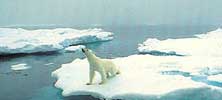
No need for air-con
A frozen “Noah’s Ark” to safeguard the world’s crop seeds from cataclysms is being built on a remote Arctic island off Norway, but the operation seems badly misconceived. It will replace a smaller facility currently on the same site.
Completion of the Global Seed Vault, in a mountainside on the island of Svalbard 1,000 km (600 miles) from the North Pole, is due September 2007. Built with Fort Knox-type security, the depository will preserve around two million seeds representing all known varieties of the world’s crops at sub-zero temperatures.
The Prime Ministers of five Nordic countries launched the huge underground storage vault last June. It will hold millions of seeds from all over the world. Some call it a doomsday vault, others, a Noah’s Ark for global agriculture. But while the existing facility is off-grid, a simple steel container down a disused mine shaft the new vault is envisaged as a 24-hour, air conditioned cold store, adding to global warming and prone to all the problems of power failure and mismanagement that it is intended to solve.
The steel container, big as a trailer, filled with seeds is now in service deep in the mountain, inside permafrost. It’s about 26 degrees in there. Ice crystals cover the walls. Some would say it is all that is needed, apart from some security guards.
It’s filled with long glass tubes, themselves full of seeds, or a few hundred beans. They’ve been in here for 22 years. If you planted them, though, they’d grow just as well as last year’s harvest. This is an agricultural gene bank, a small one. There are hundreds of them around the world. They hold samples of 100,000 kinds of rice and a 1,000 kinds of wheat, many as different from each other as a beagle and a Great Dane.
It seems just vanity to centralize them all in one place where they are prone to terrorist attack, power failure, meteorites or any number of calamities. The project is the brainchild of one Cary Fowler, publicity-hungry Executive Director of the Global Crop Diversity Trust based in Rome.
This is the most valuable natural resource in the world, enthuses Fowler. This is the biological foundation for agriculture. So in other words, as long as we intend to be on earth ourselves, we’re going to need this diversity. But there is nothing diverse about Fowler’s storage plans he sees himself as the Man who Guards our Agricultural Heritage. Its all expensive and unnecessary and expensive – $10 million to build and about $1 million a year to manage.
Most of the varieties in the vault don’t grow in fields anymore. Farmers replaced them over the last century with standard crop varieties that grow better or produce more. So when plant breeders want to improve a crop, they have to turn to the gene banks to find plant varieties that can resist drought or survive disease. And Norway now plans to build the world’s biggest gene bank. It will hold three million seed samples inside that same mountain on Svalbard where the small collection is stored.
Prime Minister Jens Stoltenmberg of Norway says: It is of global importance to build such a seed bank because it will take care of seeds from all over the world. And it will be the only kind of its kind in the world.
“This facility will provide a practical means to reestablish crops obliterated by major disasters,” said Fowler.
He said crop diversity was imperilled not just by a cataclysmic event, such as a nuclear war, “but also by natural disasters, accidents, mismanagement, and short-sighted budget cuts.’
The new vault will be a lot bigger than the steel chamber in the coal mine. It will also be much colder, refrigerated artificially to 40 below zero. So global warming shouldn’t be a problem. It’s suppose to hold a secure backup copy of seed samples held by hundreds of gene banks all over the world in case disaster strikes there.
As many polar bears live here as people. The 2000 people who stick it out through the winter don’t see the sun for almost four months. Of course this time of year the sun never sets. The vault is supposed to be finished by the end of next summer. The project’s supporters hope it just won’t preserve seeds, but also capture people’s imaginations. It’s a symbol, they say, of just how precious and irreplaceable those old seeds are.
The seeds would be stored at -18 Celsius (-0.40F). If the power failed, the seeds would probably stay frozen.
“The temperature there is around -3C, -4C in the summer but we believe that even if the freezers broke down a suitable temperature would last for months,” said Grethe Helene Evjen, a senior adviser at the Agriculture Ministry.
“This will be primarily a duplicate storage for plant seeds already stored elsewhere,” she told Reuters. Seeds would remain the property of nations making deposits.
Norway would provide 30 million Norwegian crowns ($4.94 million) to build the vault. Prime Minister Jens Stoltenberg would mark the start of construction during a meeting of prime ministers from the Nordic region on the island on June 19.
Norway has long talked of building the Arctic seed vault without previously taking action. For about 15 years some varieties of seed have been stored in a disused Svalbard mine under a plan to see if they can germinate after 100 years.
Norway has worked with the U.N.’s Food and Agriculture Organization on the plans. It would also get financial support from the Global Crop Diversity Trust to help poor countries use the storage.